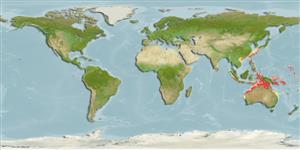>
Pleuronectiformes (Flatfishes) >
Cynoglossidae (Tonguefishes) > Cynoglossinae
Etymology: Paraplagusia: Greek, para = the side of + Greek, plagos, plagios = oblique; longirostris: longirostris from the Latin meaning 'long snout'.
Environment: milieu / climate zone / depth range / distribution range
Écologie
marin démersal; profondeur 12 - 86 m (Ref. 9224). Tropical
Indo-West Pacific: northern Australia and southern coast of Papua New Guinea.
Taille / Poids / Âge
Maturity: Lm ? range ? - ? cm
Max length : 27.6 cm SL mâle / non sexé; (Ref. 9224)
Rayons mous dorsaux (Total) : 133 - 143; Rayons mous anaux: 102 - 112. Caudal vertebrae 49-55; mid-lateral line scales 115-125. Differs from all other species in the genus Paraplagusia by the non-overlapping high counts for the dorsal and anal fin rays, caudal vertebrae and mid-lateral line scales.
Life cycle and mating behavior
Maturité | Reproduction | Frai | Œufs | Fécondité | Larves
Chapleau, F., C.B. Renaud and P.J. Kailola, 1991. Paraplagusia longirostris, a new flatfish (Cynoglosidae) from Australia and Papua New Guinea. Jap. J. Ichthyol. 38(3):239-244. (Ref. 9224)
Statut dans la liste rouge de l'IUCN (Ref. 130435: Version 2024-1)
Menace pour l'homme
Harmless
Utilisations par l'homme
Pêcheries: sans intérêt
Outils
Articles particuliers
Télécharger en XML
Sources Internet
Estimates based on models
Preferred temperature (Ref.
123201): 24.8 - 28.8, mean 27.7 °C (based on 402 cells).
Phylogenetic diversity index (Ref.
82804): PD
50 = 0.5156 [Uniqueness, from 0.5 = low to 2.0 = high].
Bayesian length-weight: a=0.01047 (0.00432 - 0.02536), b=3.04 (2.83 - 3.25), in cm total length, based on LWR estimates for this (Sub)family-body shape (Ref.
93245).
Niveau trophique (Ref.
69278): 3.5 ±0.4 se; based on size and trophs of closest relatives
Résilience (Ref.
120179): Milieu, temps minimum de doublement de population : 1,4 à 4,4 années (Preliminary K or Fecundity.).
Fishing Vulnerability (Ref.
59153): Low vulnerability (24 of 100).
